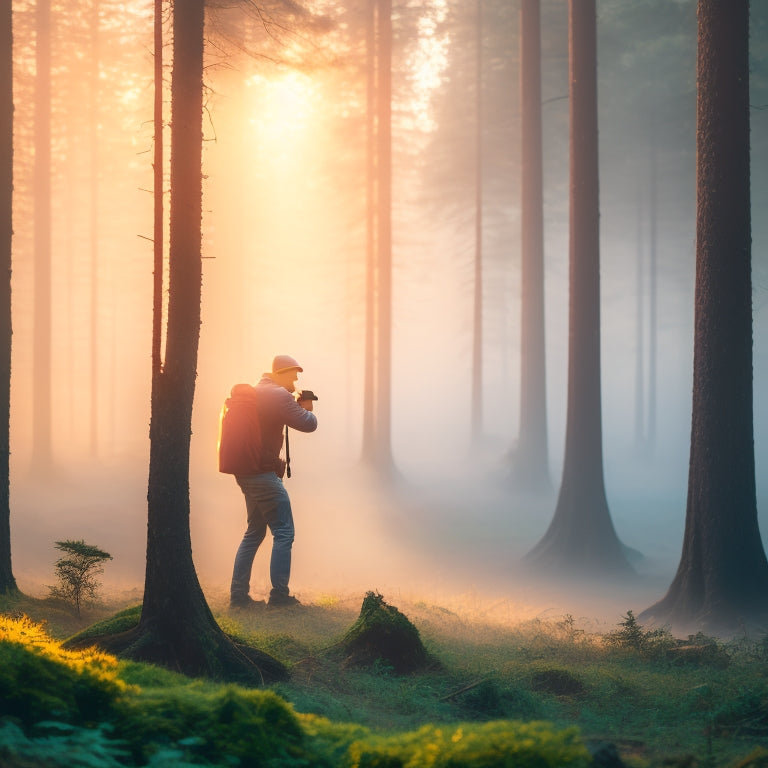
5 Outdoor Photography Essentials for Stunning Portraits
Share
You're about to discover the secrets to capturing outdoor portraits that will leave your subjects breathless! Mastering natural light conditions is key - think golden hour's soft, warm glow and dramatic long shadows. Next, choose the right camera gear for the job, like a full-frame sensor and lens filters. Then, find an outdoor backdrop that complements your subject, from urban landscapes to rural serenity. Capture movement and flow by adjusting shutter speed and panning with your subject. Finally, edit for dramatic effect with color grading and local adjustments. As you combine these essentials, the possibilities will unfold...
Key Takeaways
• Master golden hour for soft, warm light and dramatic shadows that add romance and depth to portraits.
• Choose the right camera gear, including a full-frame sensor and lens filters, to enhance color accuracy and reduce glare.
• Select diverse outdoor backdrops, such as urban landscapes or rural settings, to evoke a specific mood or atmosphere.
• Adjust shutter speed to capture movement and flow, creating dynamic energy and adding life to portraits.
• Edit portraits with contrast, exposure, and selective sharpening to create dramatic effect and transform them into mesmerizing works of art.
Mastering Natural Light Conditions
As you venture out into the great outdoors with camera in hand, mastering the ever-changing dance of natural light is essential to capturing breathtaking images. The golden hour, that fleeting moment just before sunrise and after sunset, is a photographer's holy grail. Soft, warm light bathes your subject, casting long shadows and imbuing your portraits with a sense of drama and romance.
But what about those cloudy days when the sun hides behind a veil of grey? Don't worry, overcast skies can be a blessing in disguise. The soft, diffused light reduces harsh shadows, making it ideal for capturing subtle expressions and textures. It's also a great opportunity to experiment with reflections and contrast.
Choosing the Right Camera Gear
With your creative vision and natural light mastery in place, it's time to pair them with the perfect camera gear, an essential step in translating your artistic vision into tangible, jaw-dropping images.
As you venture into the world of outdoor photography, you'll soon realize that the right camera gear can make all the difference. You'll want to take into account the sensor size, which affects the camera's low-light performance and depth of field. A full-frame sensor, for instance, will provide better image quality and shallower depth of field compared to a crop sensor.
| Camera Feature | Why It Matters |
|---|---|
| Sensor Size | Affects low-light performance and depth of field |
| Lens Filters | Enhances color accuracy and reduces glare |
| Image Stabilization | Reduces camera shake and blur |
When choosing your gear, don't overlook lens filters, which can enhance color accuracy and reduce glare. Additionally, look for cameras with image stabilization to reduce camera shake and blur. With the right gear in hand, you'll be well on your way to capturing stunning portraits that leave a lasting impression.
Working With Outdoor Backdrops
Now that you're equipped with the perfect camera gear, it's time to venture out and tap into the full potential of outdoor backdrops, where every rock, tree, and cloud can become a stunning element in your composition.
You're no longer limited to a studio setting, and the world is your canvas. Urban landscapes, with their sleek skyscrapers and bustling streets, offer a modern, edgy vibe that's perfect for capturing bold, contemporary portraits. On the other hand, rural settings with their rustic textures and rolling hills evoke a sense of timelessness and serenity.
When working with outdoor backdrops, consider the time of day and how it affects the light. Golden hour, just before sunset, is a favorite among photographers for its warm, soft tones. Don't be afraid to experiment with unusual vantage points, like climbing a hill or shooting from a low angle, to add depth and drama to your portraits.
Capturing Movement and Flow
You're poised to elevate your outdoor portraits by capturing the dynamic energy of movement and flow, capturing fleeting moments in time that reveal the subject's personality and spirit.
As you anticipate the action, your camera becomes an extension of your creative vision, ready to capture the fluid motion of your subject. To reveal moments, you'll need to adjust your shutter speed to at least 1/1000th of a second, allowing you to halt the action in its tracks.
However, don't be afraid to experiment with slower shutter speeds to create blurry silhouettes, adding an air of mystery and dynamism to your portraits. By panning with your subject, you'll create a sense of motion, blurring the background while keeping your subject sharp.
Editing for Dramatic Effect
As you explore the domain of post-processing, a world of creative possibilities unfolds, where subtle tweaks can elevate your outdoor portraits from mere captures to mesmerizing works of art. The editing process is where the magic happens, and your portraits transform into stunning masterpieces.
Here are 4 essential editing techniques to add drama to your outdoor portraits:
-
Color grading: Apply a consistent color tone to create a cohesive look and evoke a specific mood. Warm tones can evoke a sense of nostalgia, while cool tones can create a sense of calm.
-
Local adjustments: Make targeted adjustments to specific areas of the image, such as brightening the subject's eyes or enhancing the colors of the surrounding landscape.
-
Contrast and exposure: Balance contrast and exposure to create depth and dimension in your image. This will draw the viewer's attention to the subject and create a sense of drama.
- Selective sharpening: Apply selective sharpening to emphasize the subject's features and create a sense of clarity, while subtly blurring the background to create a sense of context.
Frequently Asked Questions
How Do I Handle Difficult Clients During Outdoor Photography Sessions?
When dealing with difficult clients, you're steering through a stormy sea, but stay anchored by setting clear boundaries and educating them on your process, ensuring a smooth sail to capturing stunning portraits.
What's the Best Way to Scout Outdoor Locations Without Trespassing?
'When scouting outdoor locations, you'll often encounter private property; make sure you respect land access rules, seeking permission or permits when needed, to avoid trespassing and potential legal issues.'
Can I Use Outdoor Photography to Capture Stunning Portraits of Pets?
'You'll capture stunning pet portraits by harnessing natural light to highlight their unique expression, using the great outdoors as your studio - get ready to reveal their wild side and snap unforgettable moments!'
How Do I Protect My Camera Gear From Harsh Outdoor Weather Conditions?
"Did you know 75% of camera damage occurs due to water and moisture? You won't be caught off guard when you invest in weather-sealed gear and rain covers, shielding your equipment from harsh weather conditions, ensuring your creative vision stays intact."
Are There Any Specific Model Releases Required for Outdoor Photography?
"When you're capturing stunning portraits outdoors, you'll need to secure model permissions and location permits to avoid legal hassles, so research and obtain necessary releases and permits before clicking that shutter, got it?"
Related Posts
-

3 Ways to Monetize Your Dance Expertise Online
You can harness your dance expertise into a lucrative online business by leveraging your skills in three key ways. Yo...
-

Three Clicks Revolutionizes Online Marketplace Experience
Three Clicks is revolutionizing the online marketplace experience by seamlessly connecting buyers and sellers through...
-

Missouri Star Unveils New Ribbon Dance Pattern
Missouri Star Quilt Co. introduces the Ribbon Dance Pattern, a vibrant 10 Square (Layer Cake) design that showcases b...


